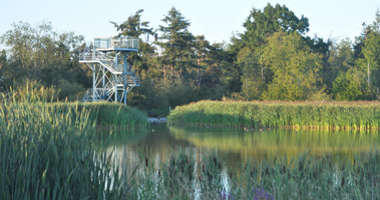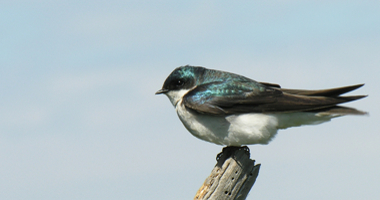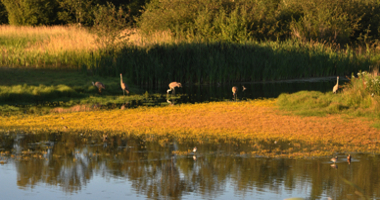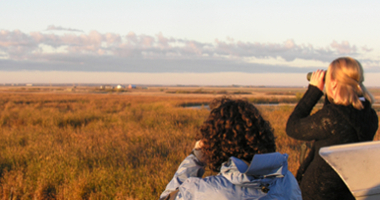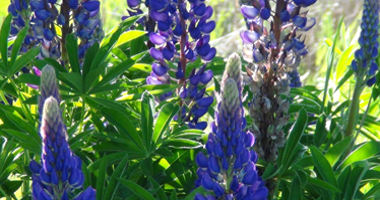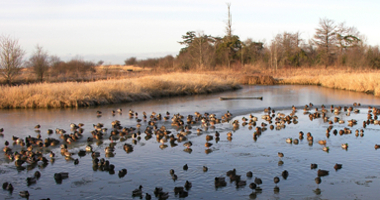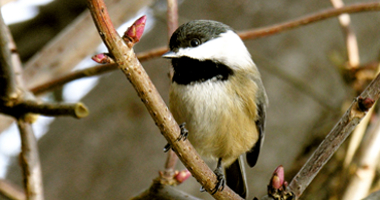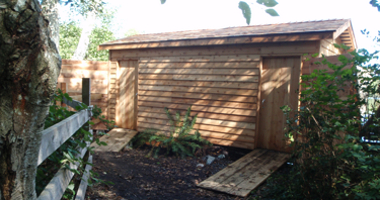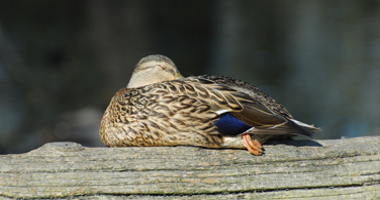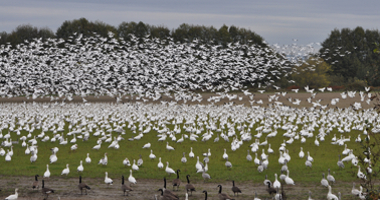About The Sanctuary

The George C. Reifel Migratory Bird Sanctuary consists of nearly 300 hectares (850 acres) of managed wetlands, natural marshes and low dykes in the heart of the Fraser River Estuary. For the millions of birds seeking feeding and resting areas during their annual migrations along the Pacific Coast, the Sanctuary is ideally located. It is a place where wildlife and their habitats are protected from harm, and it lies next to miles of flat marshland and the farmland of Westham Island.
In The Beginning
The Sanctuary is located on the outskirts of the Village of Ladner, in Delta, BC. In the early 1900's, protective dykes had been built along the Fraser River to protect Ladner's thriving farming and fishing-based community from the Fraser River and the tidal waters of the Strait of Georgia. Nearby river islands, though, were only partially dyked or left to flood each year naturally, and were often sites of fishing camps which supplied the numerous local salmon canneries.
The northwest part of Westham Island consisted of such undyked islands when George C. Reifel bought his property in 1927. Natural river channels such as Ewen, Robertson and Fuller Sloughs dissected the property and retain their names still within the Sanctuary waterways. Although all equipment and building materials needed to be barged in, by 1929, Mr. Reifel had created a large recreational family retreat in this idyllic location. Dykes and causeways were constructed to create waterfowl habitats and road access connecting his land ("Reifel Island") to the rest of Westham Island. Although the family ran successful real estate and brewery businesses, Reifel Farm, as it became known, was also very successful, and during WW2 was responsible for over one-third of the sugar beet seed production of Canada.
A Meeting Of Minds
In the 1960's, his son, George H. Reifel, granted the first lease to the British Columbia Waterfowl Society for a Bird Sanctuary to be named after his late father. Ducks Unlimited Canada was brought in to assist with the water management of the many wetland habitats on the site, and has continued to be an active partner in the management of the area. The provincial government supplemented this effort by establishing a game reserve on the adjacent intertidal foreshore. By 1972, there was widespread recognition of both the real estate value and the wildlife habitat value of the Reifel homestead, waterways, farm fields, and Sanctuary area. To conserve the entire area, the Reifel family agreed to a combination of land sale and donation to the federal government on the condition that it would continue to be managed for the primary benefit of waterfowl and that the Sanctuary would continue to bear the name of George C. Reifel.
With this change in ownership, the federal government designated the farm site as the Alaksen National Wildlife Area and the provincial game reserve and the Sanctuary lease area were designated the George C. Reifel Migratory Bird Sanctuary. The Reifel family home now serves as the regional headquarters of the Canadian Wildlife Service (CWS) which is part of Environment Canada. CWS administers these lands, with the Sanctuary managed by the British Columbia Waterfowl Society under a long-term license. Under this kind of federal land ownership, activities are regulated through permits, and their wildlife and habitats are protected under the Canada Wildlife Act, the Migratory Birds Convention Act and the BC Wildlife Act.
Click on Environment Canada's map (above) to visit their website to learn more about the Alaksen National Wildlife Area, its management, and how the two designated protected wildlife areas overlap.
In 2013, the Sanctuary passed its 50th anniversary. It is now one of the more popular nature viewing area in the Greater Vancouver metropolitan area in southwestern British Columbia and is ranked as one of the top ten bird-watching sites in Canada . Visitors are a mix of birdwatchers, students participating in school programs, and a mix of family groups, birding and sight-seeing groups, and photographers.
Status
The Sanctuary is a key habitat component within the Fraser River estuary, and has been recognized for its importance to birds through many programs and legal designations.
Federal Migratory Bird Sanctuary (as above)
The George C. Reifel Migratory Bird Sanctuary is one of 92 of these protected areas across Canada termed bird sanctuaries by the Government of Canada and providing safe refuge for our migratory birds.
National Wildlife Area (as aboove)
Canada's 54 National Wildlife Areas (NWA) cover approximately 1 million hectares (ha) of nationally significant land and marine habitats. The Alaksen NWA boundaries overlap with the Reifel Migratory Bird Sanctuary boundaries, strengthening the laws protecting birds in both areas.
Canada's Important Bird and Biodiversity Area
Canada’s Important Bird and Biodiversity Areas Program is a science-based initiative to identify, conserve, and monitor a network of sites that provide essential habitat for Canada’s bird populations. The 750 square kilometer IBA covering the Fraser River delta includes the Sanctuary lands.
Ramsar Site
The Sanctuary and the Alaksen National Wildlife Area are a Ramsar site. The Ramsar Convention was attended by 120 countries in 1971 in Ramsar, Iran, and set criteria for protecting globally important wetlands.The Fraser River Delta greatly exceeds the criteria for waterfowl and shorebirds. Initially, the Ramsar site included the Alaksen NWA and the Sanctuary, but in 2012, it was expanded to include Burns Bog, and the provincial Wildlife Management Areas of Sturgeon Banks, South Arm Marshes Wildlife Management Area, Boundary Bay And Serpentine Marsh.
WHSRN Site
The Fraser delta is also globally important to shorebird populations, and is a designated WHSRN site. WHSRN stands for the Western Hemispheric Shorebird Reserve Network, an international initiative to identify and protect habitats in key stopover points used by shorebirds during their long migrations across North and South America (the Western Hemisphere).




